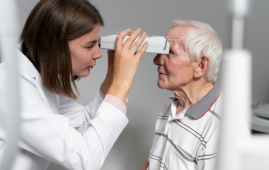

According to a Rutgers study, the criteria used by neurologists to evaluate for multiple sclerosis (MS) in adults may miss the sickness in youngsters with imaging that is suggestive of the condition. This oversight could postpone the treatment of the disease at its earliest stages.
The main method for diagnosing MS is magnetic resonance imaging (MRI), and over time, medical professionals have utilized a variety of criteria to categorize those who are most prone to get the illness. The McDonald’s criterion, the most recent standard, was last revised in 2017.
A phenomenon called a radiologically isolated syndrome, where imaging suggestive of MS is discovered by chance before the illness develops occurs in some circumstances (RIS). But after reviewing the MRIs of children with RIS, researchers determined these criteria are likely insufficient for pediatric patients.
“In our study, not all patients met the McDonald or Barkhof criteria [the current standard for diagnosing adult RIS], yet some went on to develop MS,” said Vikram Bhise, director of Child Neurology and Developmental Disabilities at Rutgers Robert Wood Johnson Medical School, and lead author of the study published in the journal Multiple Sclerosis and Related Disorders. “This suggests that the criteria used to characterize RIS in adults might be insufficient for the younger population.”
Researchers analyzed MR images of children suspected of having demyelination, or damage to the protective myelin sheath that surrounds nerve fibers in the brain, in order to ascertain whether children with abnormal MRI findings would develop symptoms associated with MS and to comprehend how diagnostic tools used for adults apply to children.
Nerve impulses slow or even cease when the myelin sheath is compromised, leading to neurological problems. On an MRI, this damage appears as lesions, which are white or grey patches. The majority of aberrant MRI findings are caused by factors other than demyelination. Despite the fact that not all individuals with MRI results indicative of demyelination go on to develop MS, a sizable percentage do.
Databases from the Rutgers Robert Wood Johnson Medical School and the U.S. Network of Pediatric Multiple Sclerosis Centers were used to find study participants. Patients ranged in age from 7.6 to 17.8 years, and everyone demonstrated demyelination on their MRIs.
At the time of their initial MRI, none of the study’s young participants showed any of the physical or neurological symptoms associated with MS, such as blurred or lost vision, vertigo, or numbness or weakness in one or both legs. Bhise said that headaches were the most frequent cause for testing even though the database didn’t record this information.
After an initial evaluation of the MRI results, patient data was evaluated over an average time period of 3.7 years to track the emergence of new lesions or the first MS event. Of the 38 patients included in the study, 14 of 35 (40 percent) developed a new clinical episode and 27 of 37 (73 percent) exhibited new MRI lesions during the review period.
Several patients continued to develop MS even after failing to meet the McDonald or Barkhof criteria, the researchers observed when they applied contemporary MS diagnostic techniques to the cohort.
“Finding MS early can help a doctor knock out a whole bunch of future problems for their patients,” Bhise said. “But that can only happen with accurate diagnostic tools.”
more recommended stories
 Atrial Fibrillation in Young Adults: Increased Heart Failure and Stroke Risk
Atrial Fibrillation in Young Adults: Increased Heart Failure and Stroke RiskIn a recent study published in.
 Neurodegeneration Linked to Fibrin in Brain Injury
Neurodegeneration Linked to Fibrin in Brain InjuryThe health results for the approximately.
 DELiVR: Advancing Brain Cell Mapping with AI and VR
DELiVR: Advancing Brain Cell Mapping with AI and VRDELiVR is a novel AI-based method.
 Retinal Neurodegeneration in Parkinson’s Disease
Retinal Neurodegeneration in Parkinson’s DiseaseBy measuring the thickness of the.
 Epilepsy Seizures: Role of Astrocytes in Neural Hyperactivity
Epilepsy Seizures: Role of Astrocytes in Neural HyperactivityRoughly 1% of people experience epilepsy.
 Role of Engineered Peptides in Cancer Immunotherapy
Role of Engineered Peptides in Cancer ImmunotherapyIn a recent publication in Nature.
 CRISPR-Cas9 Gene Therapy for Prostate Cancer
CRISPR-Cas9 Gene Therapy for Prostate CancerIn their preclinical model, the researchers.
 Epilepsy Surgery: Rare Hemorrhagic Complications Study
Epilepsy Surgery: Rare Hemorrhagic Complications StudyFollowing cranial Epilepsy Surgery, hemorrhagic complications.
 Pediatric Epilepsy – Mental Health Interventions Unveiled
Pediatric Epilepsy – Mental Health Interventions UnveiledMental health challenges frequently manifest in.
 Neoadjuvant Chemotherapy Boosts Ovarian Cancer
Neoadjuvant Chemotherapy Boosts Ovarian CancerDuring the COVID-19 pandemic, US women.

Leave a Comment